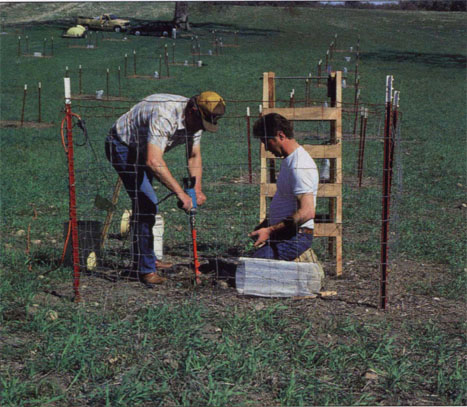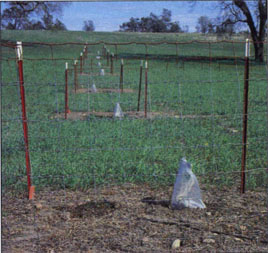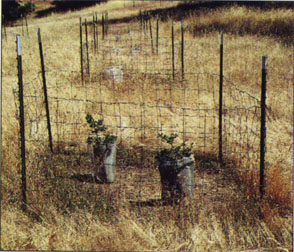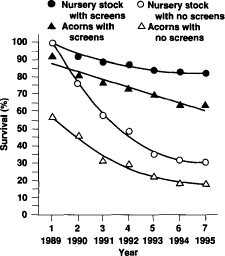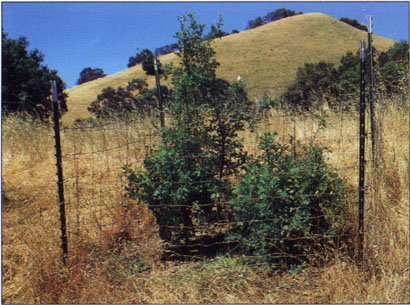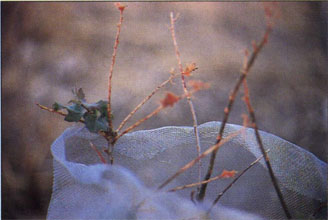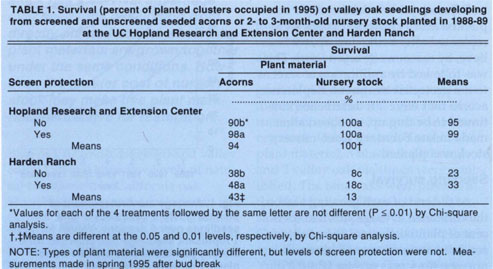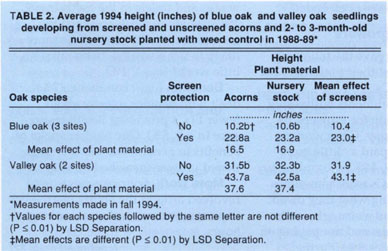All Issues
Oaks grown from nursery stock have better survival rate
Publication Information
California Agriculture 51(1):26-29. https://doi.org/10.3733/ca.v051n01p26
Published January 01, 1997
PDF | Citation | Permissions
Abstract
Studies comparing the performance of blue and valley oak seedlings developing from directly planted acorns and 2-to-3-month-old nursery stock were conducted at several locations in California. Results suggest that transplanted blue oak nursery stock has a survival advantage over seedlings developing from directly planted acorns when the plant materials are grown together under the same conditions. However, the greater cost of nursery stock may make this plant material unattractive for restoration.
Full text
Planting valley oak nursery stock in enclosures at the Ray Harden Ranch, Monterey Co., before emergence of seedlings developing from seeded acorns.
Protected and unprotected valley oak nursery stock in enclosures at the Ray Harden Ranch, Monterey Co., before emergence of seedlings.
Blue oak (Quercus douglasii) and valley oak (Q. lobata) have low levels of natural recruitment in California oak woodlands, and land development is increasingly destroying their habitat. These facts have led to an emphasis on research to help sustain this important California resource.
Two methods of planting oaks for habitat restoration and mitigation are commonly used: transplanting of nursery stock and direct planting of acorns. Weed control and protection from large and small mammals and insects are essential for either method's success. The choice between directly seeded acorns and transplanted nursery stock depends on a number of factors, including monetary cost and the relative abilities of these plant materials to survive and grow.
We compared the survival and growth of seedlings developing from directly seeded acorns with that of transplanted, 2-to-3-month-old nursery stock. Using the two classes of plant material, 3 blue oak plantings and 2 valley oak plantings were established. The blue oaks were planted at the UC Hopland Research and Extension Center (Hopland) in Mendocino County, the UC Sierra Foothill Research and Extension Center (Sierra Foothill) in Yuba County and the George Work Ranch (Work) in Monterey County. Valley oaks were planted at Hopland and the Ray Harden Ranch (Harden) in Monterey County.
Planting sites
Blue oak was planted on upland sites with soils that support stands of the trees surrounding the planting sites; valley oak was planted on soils within typical valley oak woodlands. The herbaceous understory plants included the annual grasses and forbs found on California's oak-grassland savanna. All planting was done in open areas away from the influence of tree canopy.
Blue and valley oak acorns for the study were collected locally in fall 1988. Acorns scheduled for greenhouse propagation were placed in moist peat moss to encourage germination. Those to be seeded directly at each site were placed in cold storage (36–40°F) to delay germination until planting during November-December, the period identified through previous research as most suitable and most often recommended.
Influence of screen protection on survival and growth of blue oak seedlings in 1993 at the UC Hopland Research and Extension Center, Mendocino Co.
Nursery stock was propagated from germinated acorns, planted in 1-inch-square-by-6-inch-long plastic tubes containing a standard potting mix, and fertilized with a slow-release nitrogen applied to the surface of each tube. When transplanted in late winter, seedlings were removed from the tubes and placed in 6-inch-deep holes in the ground.
Direct planting of acorns took place after rain thoroughly wetted the top few inches of soil and germinated annual grasses and forbs. Using common trowels, acorns were planted 2 inches deep, a depth determined from previous research.
At each site, we planted the oaks inside 40, 6-foot-square enclosures erected as protection against large herbivores. Enclosures were 4 feet high and constructed from 4-inch-by-4-inch, 12-gauge, woven-wire field fencing supported with steel corner posts. Where possible, they were evenly spaced over 1 acre and placed in grazed areas to ensure that surrounding plant biomass did not accumulate and create attractive habitat for insects and small mammals that attack seedlings. Within enclosures, herbicides were used to control weeds before seedling emergence or planting of nursery stock. Weed control was maintained annually.
The enclosures represented 40 trees growing on 1 acre. We chose 40 trees because a study conducted in two north coast areas of California showed that 40 trees per acre was the optimum ratio to enhance property values.
Two clusters each of 3 directly planted acorns and 3 nursery-propagated seedlings were planted inside each enclosure with one cluster of each plant material covered by a window-screen cage to provide initial total protection from small mammals and insects. All screens were applied when nursery stock was transplanted. As the seedlings grew, cages were opened to permit unrestricted growth. Clusters of acorns and nursery stock were used to increase the probability that planted areas would remain occupied over time, allowing relative performance to be measured.
Each cluster was planted within a 6-to-8-inch-diameter circle. The four clusters in each enclosure were randomly positioned at the corners of a centered, 4-foot square, which created a randomized, complete block design with the four treatments replicated 40 times.
Analysis of variance and the Chi-square analysis were used to identify differences in survival and growth among treatments. Significant differences are reported at the 95% level of confidence unless otherwise noted.
In January 1989, the directly planted acorn clusters at Work were replanted after being dug up, we believe, by raccoons (Procyon lotor). This was followed by application of screens to the protected treatment. Replanted acorns that were left unscreened continued to be dug up, an observation made in late February when nursery stock was planted.
Seedling survival
At the end of each growing season, the combined average survival (percent of planted clusters occupied) of screened and unscreened blue oak nursery stock was greater (P ≤ 0.05) than the combined average for seedlings in the two treatments developing from directly planted acorns (fig. 1). In 1995, after six seasons, these averages were 56% and 40%, respectively.
In 1995, average survival of blue oak seedlings at the three locations was 3 times greater (P ≤ 0.01) with screen protection than without, 72% vs. 24% (fig. 1). Survival of screened nursery stock was 30% better (P ≤ 0.05) than that of screened seedlings developing from directly planted acorns (fig. 1). Rates of mortality between screened and unscreened seedlings developing from directly planted acorns were not different. Between screened seedlings in the two classes of plant material, loss was more rapid (P ≤ 0.01) for those developing from directly planted acorns, and the differential was proportional. Among unscreened seedlings, the loss rate was greater (P ≤ 0.01) for those developing from nursery stock, and the differential was nonlinear. Through the sixth season, there remained a substantial numerical difference in survival between unscreened treatments. However, because of variability in the 1995 data, statistical analysis did not suggest that a real difference existed at the end of the study.
At Hopland, survival of valley oak seedlings was high; all nursery stock clusters were occupied in 1995, and 94% of clusters planted with acorns were occupied. However, this small difference was significant (P ≤0.05). Among treatments, survival of unprotected seedlings developing from directly planted acorns was 8–10% less than that of all others (table 1).
Fig. 1. Average survival (percent of planted clusters occupied) of blue oak seedlings over 6 seasons. Values for Year 1 represent seedlings that emerged from directly planted acorns and the transplanted nursery stock.
At Harden, valley oak nursery stock was attacked by ground squirrels (Spermophilus beecheyi) immediately after planting. Screened and unscreened seedlings alike were attacked; screens were both pulled up and opened from the top to reach seedlings. Control of the rodents prevented total loss, but the average 1995 survival of seedlings developing from directly planted acorns was more than 3 times greater. Between directly planted acorn treatments, survival of protected seedlings was 18% greater (table 1).
Protection, but not class, of plant material enhanced growth of both species. In 1994, the average height of protected blue oak seedlings in all plantings was more than double that of unprotected seedlings. Protected valley oak seedlings averaged 35% taller in the two plantings of this species (table 2).
Early in the study, there were great differences among sites in expected annual rainfall. For the first two seasons, rainfall was 50% of average at the most xeric sites, Harden and Work ranches. At the more mesic sites during this period, rainfall was 70% of average (Hopland) and 100% of average (Sierra Foothill). Average rainfall at Hopland and Sierra Foothill during the first two seasons was nearly 3 times greater than at Harden and Work, and Sierra Foothill received the highest percentage of expected precipitation during the study. However, survival of blue oak in 1995 did not reflect these differences; it was 60% greater (P ≤ 0.01) at Work than at Sierra Foothill.
In 1993, valley oak seedlings that received initial screen protection at the UC Hopland Research and Extension Center, Mendocino Co., were significantly taller.
Opening screens at the George Work Ranch, Monterey Co., to release blue oak seedlings made them vulnerable to attack by meadow voles that stripped bark and leaves.
TABLE 1. Survival (percent of planted clusters occupied In 1995) of valley oak seedlings developing from screened and unscreened seeded acorns or 2- to 3-month-old nursery stock planted In 1988–89 at the UC Hopland Research and Extension Center and Harden Ranch
Rodents cause mortality
In this study, rodents were a major cause of mortality. At Harden, several factors may have contributed to the selective attack on expensive nursery stock by ground squirrels. (Cost of propagation was 30 to 40 cents per seedling, regardless of species.) Visual cues may have initiated depredation; there were both site disturbance and new seedlings. However, the fact that germinating acorns from fall planting also were present, but not disturbed, suggests something is uniquely attractive about the nursery stock.
During propagation, seedlings were well watered and fertilized. Frequent watering may have leached tannins, which are believed to discourage eastern gray squirrels (Sciurus carolinensis) and other vertebrates from consuming the embryo-containing apical portion of acorns. Fertilizer is also known to influence herbivory. For example, fertilized young conifers are more likely than unfertilized trees to be attacked by rodents. Enhanced palatabiliry of nursery stock may explain the Harden attack. Where ground squirrel populations are high, control may be necessary to prevent major loss of transplanted nursery stock.
Soil at Harden is classified as a vertisol. A high clay content contributes to shrinking and development of wide, deep cracks as the soil dries. As they develop, cracks can shear roots of young plants; this may have contributed to mortality at the site.
The cyclic occurrence of other rodents, such as meadow voles (Microtus sp.), was a problem. In 1992 and 1993, voles damaged many valley oak seedlings at Harden and blue oak seedlings at Work and continued to attack seedlings at Harden in 1994. Gophers (Thomomys bottae) were a chronic problem at all sites, but attack was usually scattered and not general.
In 1995, blue oak survival at Work, the most xeric site, was 60% greater (P ≤ 0.01) than at Sierra Foothill, which receives nearly 3 times more rainfall. Using this data, it is tempting to speculate that local genotypes have developed strategies to accommodate environmental extremes and that climatic adaptation represents a spectrum. However, the influence of small mammal and insect herbivory — scattered in time and space — in this study and other biotic factors make this a risky speculation.
Grasshoppers presented a problem, but cattle and sheep grazing, which reduced herbaceous growth and its value as cover for the insects, may have reduced the severity of their attacks. The problem was scattered in both time and space and was most obvious in 1989, when unprotected seedlings developing from directly planted acorns were attacked at Work. Again in 1992, they attacked seedlings at Work and Harden. Work was attacked a third time in 1994. After screens were opened, the insects had access to all seedlings, but early protection probably contributed to the differential in survival.
TABLE 2. Average 1994 height (inches) of blue oak and valley oak seedlings developing from screened and unscreened acorns and 2- to 3-month-old nursery stock planted with weed control in 1988–89
Protective screens provided full value for a few seasons at most; growth rates required opening of screens to permit vertical development of seedlings. After opening, the screens provided limited protection, primarily against larger rodents, such as rabbits (Sylvilagus sp.). With screens opened, rodents nipped leaders and small branches, often leaving the severed growth on the ground. This was most noticeable at the Harden valley oak site, but growth and early height measurements at all sites were affected by rodent herbivory.
Results suggest strongly that, under conditions created in this study, 2-to-3-month-old blue oak nursery stock is more likely to survive than less-expensive seedlings of this species developing from directly planted acorns. However, protection from herbivory clearly is needed to take advantage of this potential.
The size and height of seedling enclosures did not prevent damage by deer and livestock. The animals pushed against the screen fencing and reached over to browse seedlings. (Tops of enclosures were not protected with barbed wire, which might have discouraged browsing.) Cattle destroyed some enclosures. In 1995, browse damage was sufficient to discourage use of height difference as a measure of performance; many seedlings surrounded by opened protective screens had been browsed to the height of the screens.
Conclusions
With weed control, protection from large herbivores, and protection from small mammals and insects, seedlings developing from 2-to-3-month-old blue oak nursery stock may have a survival advantage over those produced from directly planted acorns growing under the same conditions. However, acorn survival was substantial with protection. Therefore, given the costs of propagating, transporting and planting seedlings, it may make economic sense to directly plant acorns for large-scale use where economic values per unit area are low, such as on the oak-grassland savanna that constitutes much of California's annual rangeland.
Rodents can present a severe problem. As identified in this study, losses to these animals can be substantial. Where oak restoration and mitigation are planned, a careful evaluation of the situation should be conducted. Intensive preplant control may be necessary. When the threat is chronic, postplant control may be required until young trees are large enough to resist attack.
Site conditions varied widely. Speculation about distinct genotypes or geographic races is tempting, but risky as we suggested, based on our data. However, oak research by others using plant materials from different sites planted together at each site has shown that, among blue oaks from coastal and inland sites, distinct geographic races exist. Common sense suggests that oaks not be grown far from the parent source in planting projects.



